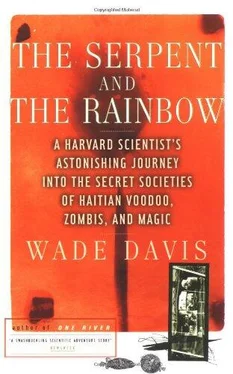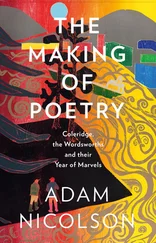Wade Davis - The Serpent and the Rainbow
Здесь есть возможность читать онлайн «Wade Davis - The Serpent and the Rainbow» весь текст электронной книги совершенно бесплатно (целиком полную версию без сокращений). В некоторых случаях можно слушать аудио, скачать через торрент в формате fb2 и присутствует краткое содержание. Год выпуска: 1985, Издательство: Simon & Schuster, Жанр: Старинная литература, на английском языке. Описание произведения, (предисловие) а так же отзывы посетителей доступны на портале библиотеки ЛибКат.
- Название:The Serpent and the Rainbow
- Автор:
- Издательство:Simon & Schuster
- Жанр:
- Год:1985
- ISBN:нет данных
- Рейтинг книги:5 / 5. Голосов: 1
-
Избранное:Добавить в избранное
- Отзывы:
-
Ваша оценка:
- 100
- 1
- 2
- 3
- 4
- 5
The Serpent and the Rainbow: краткое содержание, описание и аннотация
Предлагаем к чтению аннотацию, описание, краткое содержание или предисловие (зависит от того, что написал сам автор книги «The Serpent and the Rainbow»). Если вы не нашли необходимую информацию о книге — напишите в комментариях, мы постараемся отыскать её.
The Serpent and the Rainbow — читать онлайн бесплатно полную книгу (весь текст) целиком
Ниже представлен текст книги, разбитый по страницам. Система сохранения места последней прочитанной страницы, позволяет с удобством читать онлайн бесплатно книгу «The Serpent and the Rainbow», без необходимости каждый раз заново искать на чём Вы остановились. Поставьте закладку, и сможете в любой момент перейти на страницу, на которой закончили чтение.
Интервал:
Закладка:
If the historians have clouded the character of the struggle, they have also inaccurately idealized the revolutionary leaders—Toussaint L’Ouverture, Christophe, and Dessalines, in particular—disguising their ambitions in lofty libertarian visions that they most certainly did not have. The primary interest of the French in the immediate wake of the uprising was the maintenance of an agrarian economy devoted to the production of export crops. How this was accomplished was of little concern. Once they realized that the restoration of slavery was not possible, and before Napoleon arose to attempt to storm the island by force, the French ministers devised an alternative system whereby freed slaves as sharecroppers would be forged into a new form of indentured labor. The plantations would essentially remain intact. Lacking the military presence to enforce this scheme, the French turned to the leaders of the revolutionary armies and found willing collaborators, including Toussaint L’Ouverture, who became a major figure in the restoration of French authority on the island. The French, however, made a critical error in assuming that this co-opted leadership would submit to the whims of Paris. On the contrary, the black leadership did what they had always planned to do. They secured for themselves positions at the top of a new social order.
Toussaint L’Ouverture had no intentions of overseeing the dismantling of the colonial plantations. In the abstract he was committed to the freedom of the people, but in practice he believed that the only way to maintain the country’s prosperity and the free status of the citizens was through agricultural production. One of the most persistent myths about the Haitian revolution is the belief that the original plantations, having been destroyed in the initial uprising, never attained their former prosperity; the tacit assumption being that in the wake of the revolt the blacks who took over were incapable of governing. This is historically untrue. Within eighteen months of attaining power Toussaint L’Ouverture had restored agricultural production to two-thirds of what it had been at the height of the French colony. Had the French bourgeoisie been willing to share power with the revolutionary elite, it is possible that an export economy might have been maintained for some time. It was destined to collapse, however, not because of the lack of interest or inability of the new elite, nor even because of the chaos unleashed by Leclerc’s invasion. Its eventual demise was assured by an expedient policy begun by the French long before the revolution in 1791.
The French plantation owners, faced with the difficulty of feeding close to half a million slaves, had granted provisional plots of land so that the slaves might produce their own food. The slaves were not only encouraged to cultivate their plots, they were allowed to sell their surplus, and as a result a vast internal marketing system developed even before the revolution. Thus the plantation owners in a calculated gesture had inadvertently sown the seeds of an agrarian peasantry. Yet another lingering myth concerning the revolution asserts that once the slaves were liberated from the plantations it was virtually impossible to entice them back onto the land. In fact, in the wake of the revolt, the majority of the ex-slaves went directly to the land, and energetically produced the staple foodstuffs that the internal market of the country demanded. Reading popular accounts of the twelve-year revolutionary war, one would assume that the entire population had scavenged for its sustenance. On the contrary, they were eating yams, beans, and plantains grown and sold by the majority of ex-slaves who cultivated their lands as freemen. The problem of the revolutionary elite was not to get the people back to the land, it was to get them from their own lands back to the plantations.
An independent peasantry was the last thing the black military leaders wanted. Jean-Jacques Dessalines maintained a dream of an export economy based on chain-gang labor up until his assassination in 1806. Henri Christophe, who ruled the northern half of the country until 1820, was temporarily successful, using measures every bit as harsh as those of the colonial era. For ten years he was able to produce export crops that allowed him to build an opulent palace and support a lavish court. Yet eventually his people revolted, and with his death in 1820, there disappeared the last serious attempt to create a plantation-based economy.
What emerged in the early years of independence was a country internally vigorous but externally quiescent. Productivity of export crops declined completely. At the height of the colony, over 163 million pounds of sugar were exported annually; by 1825, total exports measured two thousand pounds, and some sugar was actually imported from Cuba. Foreigners considered the economy to be dead, and again cited the inability of blacks to organize themselves. What these statistics in fact indicated was the unwillingness of a free peasantry to submit to an economic system that depended on their labor to produce export crops that would only profit a small number of the elite. The Haitian economy had not disappeared, it had simply changed. With negligible export earnings, the central government soon went broke. As early as 1820, then President Boyer was forced to pay his army with land grants. Thus unleashing the common soldier onto the land, he dealt the final blow to any lingering dreams of reestablishing the plantations. Recognizing that no income was going to accrue from nonexistent export commodities, he began to tax the emerging structures of the peasant economy. In placing a tax on rural marketplaces, for example, he generated revenue, but more importantly from a historical perspective, he legitimized the institution itself. Then, unable to impose taxes or rents on the lands that the peasants had already taken as their own, he did the only thing that could raise income. He began officially to sell them the land. It was an extraordinary admission on the part of the central government that the peasants were in firm control of the countryside. The ex-slaves had moved onto the land, and nothing was going to pry them off it. The central government acquiesced and did what it could to generate at least some revenue from a situation that was totally beyond its control.
Yet who were these peasants who had so decisively rooted themselves to the land? Some perhaps were the descendants of the first slaves to arrive with the Spanish as early as 1510, but the majority had actually been born in Africa. Between 1775 and the outbreak of the revolution in 1791, the colony had expanded as never before. Production of cotton and coffee, for example, increased 50 percent in a mere six years, and to fuel such growth the slave population had been almost doubled. Yet because of the wretched conditions on the plantations at least seventeen thousand slaves died each year, while the birthrate remained an insignificant one percent. Hence, during the last fourteen years of undisturbed rule the French imported no fewer than 375,000 Africans. In other words, the germ of the modern Haitian peasantry quite literally sprouted in Africa.
The revolutionary slaves who settled the tortuous recesses of a mountainous island came from many parts of the ancient continent, and represented many distinct cultural traditions. Among them were artisans and musicians, herbalists, carvers, metalworkers, boatbuilders, farmers, drum makers, sorcerers, and warriors. There were men of royal blood, and others who had been born into slavery in Africa. In common was their experience with a heinous economic system that had ripped them away from their material world, but critically they also shared an oral tradition that was unassailable—a rich repository of religious belief, knowledge of music, dance, medicine, agriculture, and patterns of social organization that they carried with them into every remote valley. The evolution of these various traditions, their fusions and transformations, was deeply affected by a blanket of isolation that fell upon the country in the early years of the nineteenth century.
Читать дальшеИнтервал:
Закладка:
Похожие книги на «The Serpent and the Rainbow»
Представляем Вашему вниманию похожие книги на «The Serpent and the Rainbow» списком для выбора. Мы отобрали схожую по названию и смыслу литературу в надежде предоставить читателям больше вариантов отыскать новые, интересные, ещё непрочитанные произведения.
Обсуждение, отзывы о книге «The Serpent and the Rainbow» и просто собственные мнения читателей. Оставьте ваши комментарии, напишите, что Вы думаете о произведении, его смысле или главных героях. Укажите что конкретно понравилось, а что нет, и почему Вы так считаете.












